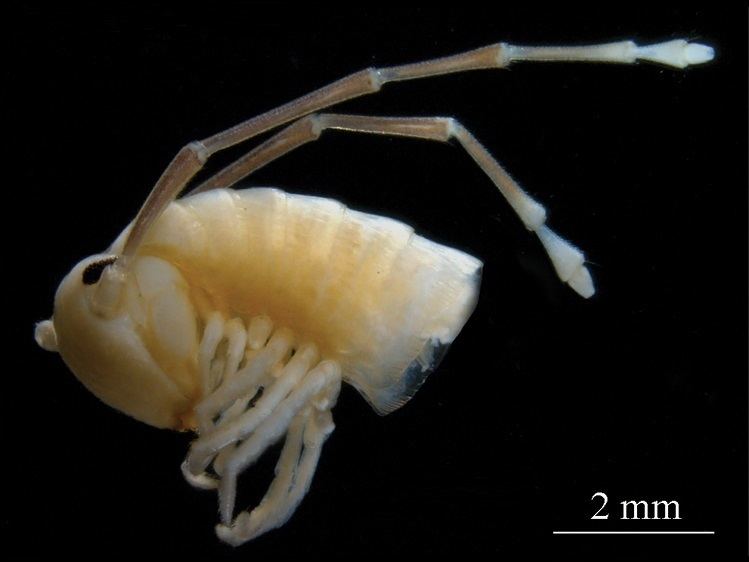A troglobite is an animal that lives entirely in the dark parts of caves. (Not to be confused with troglodyte.) Roughly speaking, troglobites may be classed as troglofauna (the land-dwelling species) and stygofauna (the aquatic species).
Troglobites typically have evolutionary adaptations to cave life. Examples of such adaptations include slow metabolism, loss of sight, and loss of skin pigment. Conversely, as opposed to lost or reduced functions, many species have extreme sensory adaptations for sense of touch or other stimuli that do not depend on light. Such adaptations may take the form of long antennae or sensory hairs, and other types of sensors, particularly chemosensory and auditory organs. Troglobites commonly do not survive well outside caves and therefore cannot travel between separate cave systems. As a result many species are endemic to a single cave or system of caves.
Strictly speaking, in contrast to troglobites, creatures that shelter in caves but go out to feed, are trogloxenes. Examples of trogloxenes include both nocturnal species such as cave-dwelling bats, and diurnal animals such as cave swallows.
Hausera hauseriTumbling Creek cavesnail (Antrobia culveri)Cave physa (Physella spelunca)Phantom cave snail (Cochliopa texana)Mimic cavesnail (Phreatodrobia imitata)ZospeumWhite cave velvet worm (Peripatopsis alba)Kauaʻi cave wolf spider (Adelocosa anops) Nelson cave spider (Spelungula cavernicola)Calicina cloughensisTexella reddelliTrogloraptor marchingtoniApochthonius mysterius – Mystery Cave pseudoscorpionApochthonius typhlus – Stone County cave pseudoscorpionHesperochernes occidentalis – guano pseudoscorpionMundochthonius cavernicolus – cavernicolous pseudoscorpionPhanetta subterranea – subterranean cave spiderPorrhomma cavernicola – cavernicolous Porrhomma spiderSinopoda scurion – eyeless huntsman spiderTroglokhammouanus steineri – Xe Bang Fai cave scorpionVietbocap lao – Nam Lot cave scorpionParobisium yosemite – Yosemite cave pseudoscorpionTitanobochia magna – cave pseudoscorpionCicurina venii – Braken Bat Cave meshweaver spiderChinquipellobunus madlae – cave harvestmanMillipedesCauseyella speciesChaetaspis aleyorum – Aleys' cave millipedeDesmoxytesMammamia profugaSinocallipusTitanophyllum spiliarumTrichopetalum whiteiTingupa pallidaZosteractis interminataCentipedesEupolybothrus cavernicolusAlabama cave shrimp (Palaemonias alabamae) Procambarus delicatus Spelaeorchestia koloana Procambarus pecki Typhlocaris Macromaxillocaris Samarplax principeCyclops vernalisHoloped amazonicumBarburia yaneziGammarus acherondytes – Illinois cave amphipodCambarus aculabrum – Benton County cave crayfishCambarus hubrichti – Salem cave crayfishCambarus setosus – bristly cave crayfishCambarus zophonastes – Hell Creek cave crayfishAndhracoides shabuddin– Guthikonda cave isopodAndhracoides gebaueri– Belum cave isopodAllocrangonyx hubrichti – Hubricht's long-tailed amphipodBactrurus brachycaudus – short-tailed groundwater amphipodBactrurus hubrichti – sword-tail cave amphipodBactrurus pseudomucronatus – false sword-tailed cave amphipodCaecidotea antricola – cave isopodCaecidotea dimorpha – Missouri cave isopodCaecidotea fustis – Fustis cave isopodCaecidotea salemensis – Salem cave isopodCaecidotea serrata – serrated cave isopodCaecidotea stiladactyla – slender-fingered cave isopodCaecidotea stygia – stygian cave isopodDiacyclops yeatmani – Yeatman's groundwater copepodOrconectes stygocaneyi – Caney Mountain cave crayfishStygobromus barri – Barr's groundwater amphipodStygobromus clantoni – Clanton's groundwater amphipodStygobromus heteropodus – Pickle Springs amphipodStygobromus onondagaensis – Onondaga cave amphipodStygobromus ozarkensis – Ozark cave amphipodStygobromus subtilis – subtle groundwater amphipodOrcovita hickskiOrcovita orchardorumCancrocaecaSee Cave insects
List of cave fishCave salamandersThere are no known mammals that live exclusively in caves. Most bats sleep in caves during the day and hunt at night, but they are considered troglophiles or trogloxenes. However some fossorials which spend their whole lives underground might be considered subterranean fauna, although they are not true troglofauna as they do not live in caves.
Beauty rat snake (Elaphe taeniura)There are no known birds that live exclusively in caves.

